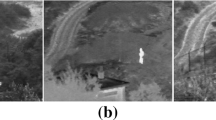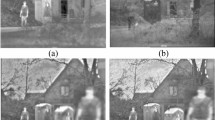Abstract
Infrared (IR) and visible (VIS) image fusion techniques are widely applied to many high-level vision tasks, such as object detection, recognition, and tracking. However, most existing image fusion algorithms exhibit varying degrees of edge-step effect and texture information degradation in their fused images. To improve the fusion quality, an IR and VIS image fusion method based on a variational partial differential equation (VPDE) model and a VGG network is proposed. A productive smoothing segmentation is integrated into the energy function of the VPDE model, which is based on a novel regularization function. To decompose source images into low-frequency and high-frequency components, the new VPDE model is employed. To fuse low-frequency components, a probabilistic parameter model based on space-alternating generalized expectation-maximization (SAGE) is utilized rather than the traditional average fusion rule. Then, multi-layer features of the high-frequency components are extracted using a VGG network. To generate several candidates of the fused detail content, the \(l_1\)-norm and weighted average rule are adopted, and the final details are obtained by using the maximum selection strategy. Finally, fused images are obtained by reconstructing the fused low-frequency and high-frequency components. Extensive experiments on the TNO and RoadScene datasets demonstrate that the proposed technique effectively eliminates artifacts as well as the step effect. In the subjective comparison, the proposed method can highlight the salient objects of the fused images while strengthening the texture information. In terms of the evaluation metrics, the proposed method outperforms 13 state-of-the-art methods in objective comparison in addition to the subjective evaluation.














Similar content being viewed by others
Data Availability
The datasets produced and/or analyzed in the research at hand are available upon reasonable request to the corresponding authors.
References
Ma J, Ma Y, Li C (2019) Infrared and visible image fusion methods and applications: A survey. Information Fusion 45:153–178. https://doi.org/10.1016/j.inffus.2018.02.004
Hao S, He T, Ma X, An B, Wen H, Wang F (2022) Nosmfuse: An infrared and visible image fusion approach based on norm optimization and slime mold architecture. Applied Intelligence pp 1–14. https://doi.org/10.1007/s10489-022-03591-4
Zhang Y, Liu Y, Sun P, Yan H, Zhao X, Zhang L (2020) Ifcnn: A general image fusion framework based on convolutional neural network. Information Fusion 54:99–118
Singh S, Mittal N, Singh H (2022) A feature level image fusion for ir and visible image using mnmra based segmentation. Neural Comput Appl 34(10):8137–8154. https://doi.org/10.1007/s00521-022-06900-7
Liu J, Wu Y, Wu G, Liu R, Fan X (2022) Learn to search a lightweight architecture for target-aware infrared and visible image fusion. IEEE Signal Process Lett 29:1614–1618. https://doi.org/10.1109/LSP.2022.3180672
Xu X, Liu G, Bavirisetti DP, Zhang X, Sun B, Xiao G (2022) Fast detection fusion network (fdfnet): An end to end object detection framework based on heterogeneous image fusion for power facility inspection. IEEE Trans Power Delivery 37(6):4496–4505. https://doi.org/10.1109/TPWRD.2022.3150110
Zhang H, Xu H, Tian X, Jiang J, Ma J (2021) Image fusion meets deep learning: A survey and perspective. Information Fusion 76:323–336. https://doi.org/10.1016/j.inffus.2021.06.008
Gao Y, Ma S, Liu J (2022) Dcdr-gan: A densely connected disentangled representation generative adversarial network for infrared and visible image fusion. IEEE Trans Circuits Syst Video Technol. https://doi.org/10.1109/TCSVT.2022.3206807
Li H, Wu XJ, Kittler J (2021) Rfn-nest: An end-to-end residual fusion network for infrared and visible images. Information Fusion 73:72–86. https://doi.org/10.1016/j.inffus.2021.02.023
Chen J, Li X, Luo L, Mei X, Ma J (2020) Infrared and visible image fusion based on target-enhanced multiscale transform decomposition. Inf Sci 508:64–78. https://doi.org/10.1016/j.ins.2019.08.066
Ding Z, Wang T, Sun Q, Wang H (2021) Adaptive fusion with multi-scale features for interactive image segmentation. Appl Intell 51(8):5610–5621. https://doi.org/10.1007/s10489-020-02114-3
Hu Z, Liang W, Ding D, Wei G (2021) An improved multi-focus image fusion algorithm based on multi-scale weighted focus measure. Appl Intell 51(7):4453–4469. https://doi.org/10.1007/s10489-020-02066-8
Dinh PH (2021) Multi-modal medical image fusion based on equilibrium optimizer algorithm and local energy functions. Appl Intell 51(11):8416–8431. https://doi.org/10.1007/s10489-021-02282-w
Chen Y, Liu A, Liu Y, Qian R, Xie Q, Chen X (2022) Image fusion with sparse representation: A novel local contrast-based preprocessing strategy. IEEE Sensors Letters 6(5):1–4. https://doi.org/10.1109/LSENS.2022.3170744
Wang C, Wu Y, Yu Y, Zhao JQ (2022) Joint patch clustering-based adaptive dictionary and sparse representation for multi-modality image fusion. Mach Vis Appl 33(5):1–16. https://doi.org/10.1007/s00138-022-01322-w
Xu H, Ma J, Jiang J, Guo X, Ling H (2020) U2fusion: A unified unsupervised image fusion network. IEEE Trans Pattern Anal Mach Intell 44(1):502–518. https://doi.org/10.1109/TPAMI.2020.3012548
Ma J, Xu H, Jiang J, Mei X, Zhang XP (2020) Ddcgan: A dual-discriminator conditional generative adversarial network for multi-resolution image fusion. IEEE Trans Image Process 29:4980–4995. https://doi.org/10.1109/TIP.2020.2977573
Li Y, Liu G, Bavirisetti DP, Gu X, Zhou X (2023) Infrared-visible image fusion method based on sparse and prior joint saliency detection and latlrr-fpde. Digital Signal Processing 134:103910. https://doi.org/10.1016/j.dsp.2023.103910
Li G, Lin Y, Qu X (2021) An infrared and visible image fusion method based on multi-scale transformation and norm optimization. Information Fusion 71:109–129. https://doi.org/10.1016/j.inffus.2021.02.008
Li X, Chen H, Li Y, Peng Y (2022) Mafusion: Multiscale attention network for infrared and visible image fusion. IEEE Trans Instrum Meas 71:1–16. https://doi.org/10.1109/TIM.2022.3181898
Jca B, Xl A, Ll C, Xm D, Jmb D (2020) Infrared and visible image fusion based on target-enhanced multiscale transform decomposition. Inf Sci 508:64–78. https://doi.org/10.1016/j.ins.2019.08.066
Singh T, Nair RR (2019) Multi sensor medical image fusion using pyramid based discrete wavelet transform:a multi-resolution approach. IET Image Proc 13(9):1447–1459. https://doi.org/10.1049/iet-ipr.2018.6556
Li X, Zhou F, Tan H, Chen Y, Zuo W (2021) Multi-focus image fusion based on nonsubsampled contourlet transform and residual removal. Signal Process 184:108062. https://doi.org/10.1016/j.sigpro.2021.108062
Yan H, Li Z (2020) Infrared and visual image fusion based on multi-scale feature decomposition. Optik 203:163900. https://doi.org/10.1016/j.ijleo.2019.163900
Xu H, Wang X, Ma J (2021) Drf: Disentangled representation for visible and infrared image fusion. IEEE Trans Instrum Meas 70:1–13. https://doi.org/10.1109/TIM.2021.3056645
Ma J, Zhang H, Shao Z, Liang P, Xu H (2020) Ganmcc: A generative adversarial network with multiclassification constraints for infrared and visible image fusion. IEEE Trans Instrum Meas 70:1–14. https://doi.org/10.1109/TIM.2020.3038013
Ma J, Yu W, Liang P, Li C, Jiang J (2019) Fusiongan: A generative adversarial network for infrared and visible image fusion. Information fusion 48:11–26. https://doi.org/10.1016/j.inffus.2018.09.004
Tang L, Yuan J, Ma J (2022) Image fusion in the loop of high-level vision tasks: A semantic-aware real-time infrared and visible image fusion network. Information Fusion 82:28–42. https://doi.org/10.1016/j.inffus.2021.12.004
He K, Cao X, Shi Y, Nie D, Gao Y, Shen D (2019) Pelvic organ segmentation using distinctive curve guided fully convolutional networks. IEEE Trans Med Imaging 38(2):585–595. https://doi.org/10.1109/TMI.2018.2867837
Yu X, Ye X, Zhang S (2022) Floating pollutant image target extraction algorithm based on immune extremum region. Digital Signal Processing 123:103442. https://doi.org/10.1016/j.dsp.2022.103442
Yu X, Tian X (2022) A fault detection algorithm for pipeline insulation layer based on immune neural network. Int J Press Vessels Pip 196:104611. https://doi.org/10.1016/j.ijpvp.2022.104611
Yu X, Zhou Z, Gao Q, Li D, Rha K (2018) Infrared image segmentation using growing immune field and clone threshold. Infrared Physics & Technology 88:184–193. https://doi.org/10.1016/j.infrared.2017.11.029
Yu X, Lu Y, Gao Q (2021) Pipeline image diagnosis algorithm based on neural immune ensemble learning. Int J Press Vessels Pip 189:104249. https://doi.org/10.1016/j.ijpvp.2020.104249
Ngo L, Cha J, Han JH (2020) Deep neural network regression for automated retinal layer segmentation in optical coherence tomography images. IEEE Trans Image Process 29:303–312. https://doi.org/10.1109/TIP.2019.2931461
Ma J, Zhou Y (2020) Infrared and visible image fusion via gradientlet filter. Comput Vis Image Underst 197–198:103016. https://doi.org/10.1016/j.cviu.2020.103016
Li H, Wu XJ, Kittler J (2018) Infrared and visible image fusion using a deep learning framework. In: 2018 24th international conference on pattern recognition (ICPR), IEEE, pp 2705–2710. https://doi.org/10.1109/ICPR.2018.8546006
Shreyamsha Kumar B (2015) Image fusion based on pixel significance using cross bilateral filter. SIViP 9(5):1193–1204. https://doi.org/10.1007/s11760-013-0556-9
Ma J, Zhou Z, Wang B, Zong H (2017) Infrared and visible image fusion based on visual saliency map and weighted least square optimization. Infrared Physics & Technology 82:8–17. https://doi.org/10.1016/j.infrared.2017.02.005
Sun P, Wang C, Li M, Liu L (2021) Partial differential equations-based iterative denoising algorithm for movie images. Adv Math Phys. https://doi.org/10.1155/2021/8176746
Bavirisetti DP, Dhuli R (2015) Fusion of infrared and visible sensor images based on anisotropic diffusion and karhunen-loeve transform. IEEE Sens J 16(1):203–209. https://doi.org/10.1109/JSEN.2015.2478655
Bavirisetti DP, Xiao G, Liu G (2017) Multi-sensor image fusion based on fourth order partial differential equations. In: 2017 20th International conference on information fusion (Fusion), IEEE, pp 1–9. https://doi.org/10.23919/ICIF.2017.8009719
Liu Y, Zhou D, Nie R, Hou R, Zhou J (2020) Robust spiking cortical model and total-variational decomposition for multimodal medical image fusion. Biomed Signal Process Control 61:101996. https://doi.org/10.1016/j.bspc.2020.101996
Simonyan K, Zisserman A (2014) Very deep convolutional networks for large-scale image recognition. arXiv preprint arXiv:1409.1556 https://doi.org/10.48550/arXiv.1409.1556
Gatys LA, Ecker AS, Bethge M (2016) Image style transfer using convolutional neural networks. In: Proceedings of the IEEE conference on computer vision and pattern recognition, pp 2414–2423
Johnson KA, Becker JA (1997) The whole brain atlas. URL https://www.med.harvard.edu/AANLIB/home.htm
Toet A (2014) Tno image fusion dataset. URL https://figshare.com/articles/dataset/TNO_Image_Fusion_Dataset/1008029
Zhang Y, Zhang L, Bai X, Zhang L (2017) Infrared and visual image fusion through infrared feature extraction and visual information preservation. Infrared Physics & Technology 83:227–237. https://doi.org/10.1016/j.infrared.2017.05.007
Li H, Wu X (2018) Infrared and visible image fusion using latent low-rank representation. CoRR abs/1804.08992. https://doi.org/10.48550/arXiv.1804.08992
Li H, Jun WuX, Durrani TS (2019) Infrared and visible image fusion with resnet and zero-phase component analysis. Infrared Physics & Technology 102(103):039. https://doi.org/10.1016/j.infrared.2019.103039
Tang H, Liu G, Tang L, Bavirisetti DP, Wang J (2022) Mdedfusion: A multi-level detail enhancement decomposition method for infrared and visible image fusion. Infrared Physics & Technology 127(104):435. https://doi.org/10.1016/j.infrared.2022.104435
Ma J, Tang L, Fan F, Huang J, Mei X, Ma Y (2022) Swinfusion: Cross-domain long-range learning for general image fusion via swin transformer. IEEE/CAA Journal of Automatica Sinica 9(7):1200–1217. https://doi.org/10.1109/JAS.2022.105686
Li C, Cheng H, Hu S, Liu X, Tang J, Lin L (2016) Learning collaborative sparse representation for grayscale-thermal tracking. IEEE Trans Image Process 25(12):5743–5756. https://doi.org/10.1109/TIP.2016.2614135
Li B, Yan J, Wu W, Zhu Z, Hu X (2018) High performance visual tracking with siamese region proposal network. In: 2018 IEEE/CVF Conference on Computer Vision and Pattern Recognition, pp 8971–8980. https://doi.org/10.1109/CVPR.2018.00935
Acknowledgements
This work is supported by the National Natural Science Foundation of China (62203224) and Shanghai Special Plan for Local Colleges and Universities for Capacity Building (22010 501300).
Author information
Authors and Affiliations
Corresponding author
Ethics declarations
Conflict of interest
We state that we do not have any personal or financial connections with individuals or entities that may improperly affect our work. We have no professional or personal interests that could be perceived as influencing the views expressed in our paper, "Infrared and visible image fusion based on VPDE model and VGG network," regarding any product, service, or company.
Additional information
Publisher's Note
Springer Nature remains neutral with regard to jurisdictional claims in published maps and institutional affiliations.
Rights and permissions
Springer Nature or its licensor (e.g. a society or other partner) holds exclusive rights to this article under a publishing agreement with the author(s) or other rightsholder(s); author self-archiving of the accepted manuscript version of this article is solely governed by the terms of such publishing agreement and applicable law.
About this article
Cite this article
Luo, D., Liu, G., Bavirisetti, D.P. et al. Infrared and visible image fusion based on VPDE model and VGG network. Appl Intell 53, 24739–24764 (2023). https://doi.org/10.1007/s10489-023-04692-4
Accepted:
Published:
Issue Date:
DOI: https://doi.org/10.1007/s10489-023-04692-4




